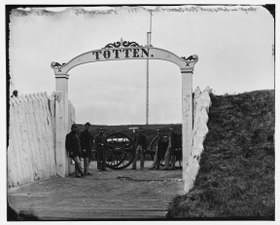History
Fort Totten was a Union Army defensive earthwork, built during the Civil War and named for Joseph Totten. It was built up during the fall of 1861, as part of the defense of Washington, D.C., during the Civil War, also known as the Fort Circle. Construction on the fort began in August 1861 and was completed in 1863. [1] [2]
Fort Totten was one of seven temporary earthwork forts built in the Northeast quadrant of the city by the Union Army to protect the city from the Confederate Army. From west to east, the forts were as follow: Fort Slocum, Fort Totten, Fort Slemmer, Fort Bunker Hill, Fort Saratoga, Fort Thayer and Fort Lincoln. Today, it has become a park administered by the National Park Service in the neighborhood of Fort Totten.
Structure
Fort Totten was a medium-sized fort, a seven-sided polygon with a perimeter of 272 yards (249 m). It was located atop a ridge along the main road from Washington to Silver Spring, Maryland, about three miles (5 km) north of the Capitol, and a half-mile from the Military Asylum or Soldiers' Home, where President Abraham Lincoln spent his summers while president. [2] The fort was of typical design for its time, with earth walls some 15 feet (4.6 m) thick and 8 feet (2.4 m) high. Outside the walls (or "ramparts") was a large ditch or dry moat over seven feet deep and twelve feet wide, and outside that was a broad cleared area surrounding a barrier of tree branches, brambles and general debris (or abatis). Along the inner surface of the wall were gun platforms for several types of cannon, some firing over the parapet, others firing through openings in it, and a banquette, a kind of shelf on which soldiers could stand to fire over the wall.
The fort had the following armament:
Wartime garrisons were manned by:
The fort saw action during the Battle of Fort Stevens on July 11 and 12, 1864 when Confederate General Jubal A. Early attacked the fort. [4]
Men and gun of 3d Massachusetts Heavy Artillery at the Fort Totten ornamental gate in 1865
Officers of Companies
A and B
3d Massachusetts Heavy Artillery and crew of 100-pdr Parrott gun on iron barbette carriage
at Fort Totten
Sergeants of 3rd Massachusetts Heavy Artillery, with gun and caisson at Fort Totten
Officers of 3rd Regiment Massachusetts Heavy Artillery
Interior view of Fort Totten
Interior of Fort Totten
Officers of Companies A and B, 3d Massachusetts Heavy Artillery, before quarters at Fort Totten
Washington, District of Columbia. James rifles in Fort Totten
This page is based on this
Wikipedia article Text is available under the
CC BY-SA 4.0 license; additional terms may apply.
Images, videos and audio are available under their respective licenses.









